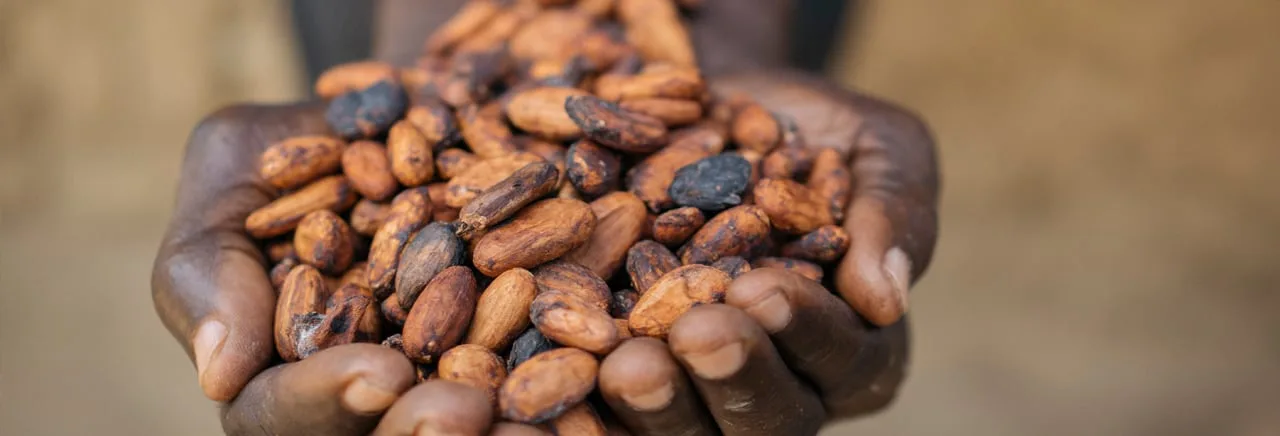Cocoa Market Turmoil: How Hershey Is Innovating Through Unprecedented Challenges
In my years in this industry, I've never witnessed a cocoa market quite like the one we're experiencing today.
Published 05-28-25
Submitted by The Hershey Company

By Mark Taylor
Senior Director of Strategic Sourcing
Key Takeaways:
- Hershey is focused on sourcing responsibly and smartly so that we can make our products and grow our business for another 130 years.
- Despite signs pointing to a cocoa surplus, prices remain volatile and disconnected from physical market realities.
- Our team are always exploring a variety of purchasing options that mean we can provide the products our consumers love at a price that keeps them accessible.
In my years in this industry, I've never witnessed a cocoa market quite like the one we're experiencing today. Every day, we see more bombastic headlines that chocolate is at risk due to cocoa supply shortages and sky-high prices. These headlines are greatly exaggerated of course, but the volatility, price swings, and market dynamics we're seeing are truly unprecedented, and I wanted to share some thoughts on what's happening and how we at Hershey are responding.
The Far-Reaching Impact of Cocoa Prices
The reality is that high cocoa prices profoundly affect our entire sector. Price has become a critical consideration for everyone—businesses, customers and consumers alike. Across the board, high prices due to inflation are impacting consumer demand, as people make tough choices about their spending. Throughout the snacking industry, companies must find creative ways to manage costs so that we can provide the products our consumers love at a price that keeps them accessible.
Today’s cocoa market is not healthy, and while external pressures like adverse weather conditions and crop disease continue, current levels of volatility are not a reasonable reflection of those impacts. The outlook is far more nuanced. While some regions face challenges with productivity, others are increasing their output. In fact, the 2024-25 year is expected to see the first surplus in four years, given factors such as:
- Production in Côte d'Ivoire and Ghana is up from last year's challenges, with arrivals currently up 20%
- Cocoa origins outside these traditional powerhouses are growing quickly and now make up roughly half of global supply
- Growth in these alternative sourcing regions is pacing at more than 10% versus the previous year
A Disconnect Between Financial and Physical Markets
All these factors should be contributing to a moderation in price. Yet, paradoxically, we continue to experience an extremely volatile cocoa market with high prices and swings that seem to defy the fundamental market outlook.
At Hershey, we're increasingly concerned that the cocoa exchanges are dysfunctional due to a lack of liquidity. The intent of commodity exchanges is to provide an orderly and fair method for buyers and sellers to achieve price transparency and hedge risk. However, we're observing a troubling disconnect—while cocoa bean prices in origin countries have fallen, prices on the exchange often move in the opposite direction.
We believe action can be taken to dampen the volatility, improve liquidity and ensure that the exchange can again perform its primary function of being an effective risk management tool for the sector.
Building a Resilient Supply Chain
While high cocoa prices impact our operations and require extreme agility, Hershey remains committed to building a resilient cocoa supply chain.
Our purpose is to Make More Moments of Goodness. This means that we believe that chocolate should be affordable and accessible. For this to continue to be possible, as an industry we must drive efficiency, resiliency and sustainability to ensure that consumers can continue to enjoy chocolate for decades to come.
We recognize a fundamental truth: without successful farmers, food businesses could not succeed. Equally, without successful businesses, there would be significantly less investment in farmers and sustainable practices.
Through Cocoa For Good, our sustainable cocoa strategy, we are making a multi-year $500 million investment, which we are busy putting to work. We have already invested more than half of that, and we've made an additional $40 million commitment to improving farmer livelihoods with our Hershey Income Accelerator Program, which we're expanding this year.
The Path Forward: Collaboration
We believe the way forward requires thoughtful collaboration. Many companies, including Hershey, have made significant investments to strengthen the cocoa supply chain, and this work must continue.
It's important to recognize that the cocoa supply chain is global, and each origin may require different solutions. There is no silver bullet or one-size-fits-all approach. What we've learned through years of experience is that creating lasting change requires a holistic approach:
- Working with governments on necessary public sector actions to foster healthy markets and support farmers
- Consistent action from companies, suppliers, and others in the private sector
- Bringing in expert implementation partners from the NGO sector to take proven, data-backed steps
In these unprecedented times, our commitment to creating a resilient cocoa supply chain remains unwavering. By working together across the entire value chain, we can navigate these challenges and build a stronger future for cocoa—from farmer to consumer.

The Hershey Company
The Hershey Company
The Hershey Company is an industry leading snacks company known for making more moments of goodness through its iconic brands, remarkable people and enduring commitment to doing the right thing for its people, planet, and communities. Hershey has more than 20,000 employees in the U.S. and worldwide who work daily to deliver delicious, high-quality products. The company has more than 90 brand names in approximately 80 countries that drive more than $11.2 billion in annual revenues, including Hershey's, Reese's, Kisses, Kit Kat®, Jolly Rancher, Twizzlers and Ice Breakers, and salty snacks including SkinnyPop, Pirate's Booty and Dot's Homestyle Pretzels.
For over 130 years, Hershey has been committed to operating fairly, ethically and sustainably. The candy and snack maker's founder, Milton Hershey, created Milton Hershey School in 1909, and since then, the company has focused on helping children succeed through equitable access to education.
To learn more visit www.thehersheycompany.com.
More from The Hershey Company

